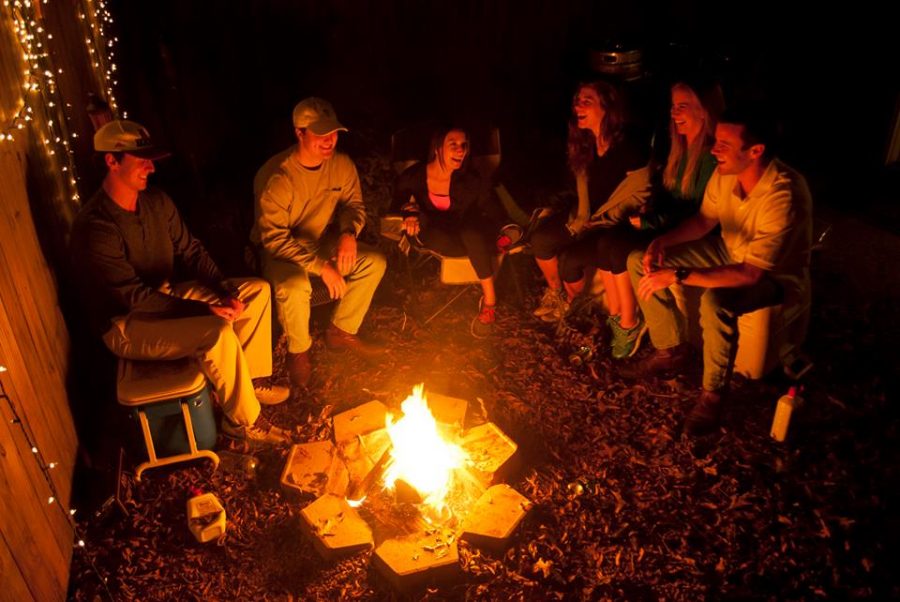Lynn, an assistant professor of anthropology, published his research in an article appearing in Evolutionary Psychology’s fifth and final issue of 2014. Lynn began teaching at the University in 2009 and started conducting research on the subject in 2010.
The idea for the study arose after Lynn read an article in graduate school suggesting campfires were linked to the existence of relaxation and stress-reducing practices in the human health repertoire. Lynn wanted to provide evidence to solidify the assumption that fire is relaxing. The first step in the research process was to identify which element of the fire is most relaxing, he said.
“I thought, because we are primarily a visual species and the largest neural network is devoted to our vision, and hypnosis is generally induced by watching things, that it was the flickering light that would be the hypnotic piece of [the fire],” Lynn said. “So we decided to isolate that, and our first iteration of the study was simply a visual fire with no sound.”
To test this, Lynn invited participants to stare at a screen with a picture of a fire and a blank screen for five minutes each. The order of each screen was randomized. In the second study, Lynn added a third condition to include a five-minute section of a fire with sound. The third study increased the time increment to 15 minutes, and the blank screen was swapped for an upside down picture of fire, without sound.
While the participants felt that sitting without anything to do for five or 15 minutes was relaxing, sitting still and staring at a screen for 45 minutes during the third study became more annoying than relaxing, Lynn said.
“Most of [the participants] felt that they were not relaxed by any of [the conditions]. The way we tested it is we took heart rate before and after each condition,” Lynn said. “And what we found is that in the fire with sound, people’s heart rate, on average, decreased in a statistically meaningful and significant way.”
Using this data, Lynn was able to confirm campfires were relaxing in a meaningful way. The evidence suggests relaxing by fires had effects on both cognition and cooperation, potentially influencing the selection for cooperation and language.
“To keep a fire going becomes pretty important. So you need people to sit around the fire and stoke and go collect things,” he said. “In a pre-linguistic period, that would have required cooperation.”
Meghan Steel graduated last May with a degree in anthropology and worked with Lynn on the research. Steel proposed to investigate a correlation between fireside relaxation and prosociality, described by Lynn as the willingness to be around people.
“My favorite part of the process was the opportunity to present at a professional conference at which I enjoyed drawing upon the backgrounds and specialties of several of my peers that I would otherwise never have met,” Steel said.
Lauren Pratt, a junior majoring in anthropology and interdisciplinary studies, worked in Lynn’s lab last fall and spring. She was responsible for running experiments and managing data. Like Steel, she appreciated the complexity of the lab, she said.
“Working in the lab showed me what doing anthropology research looks like, and that it really is science,” Pratt said.
Melinda Carr, a junior majoring in psychology and anthropology, is currently the lead research assistant in Lynn’s lab. While the first studies focused primarily on the visual elements of the fire and then eventually included some auditory elements, incorporating the element of warmth is in the works for the next study, Carr said. She is currently working with Lynn to discuss how to best execute the experiment.
“We want to do a naturalistic experiment where we actually have people sit around a campfire and we take their blood pressure and see what happens,” Carr said. “But it is hard to control variables, so that’s something we have to talk over.”
The time of day and presence of certain hormones in the body, as well as the size and type of wood used for a fire, and the number of people around the campfire are variables that would have to be considered for this type of study, Lynn said.
Lynn said he hopes to continue his study in collaboration with the National Outdoor Leadership School and also test other ideas related to the initial study.









